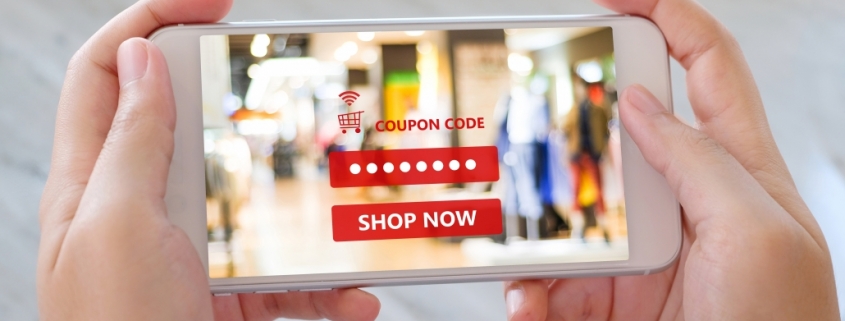HOW COUPONS AND PROMO CODES IMPROVE PERSONALIZATION
In a world where marketers get messages in front of millions of prospects with a simple click, the ability to make those offers feel personalized has become increasingly important. With personalized discounts, businesses can offer their customers more than a one-size-fits-all approach.
Everyone loves a good deal, especially when that deal feels as though it is only available to a small portion of the buying audience. When executed the right way, discounts can incentivize customers to try out a new company or look at a known business’s latest offerings. However, when a discount offer doesn’t apply to a shopper’s buying interests, email notifications and social media posts can feel ‘spammy’. So how to you hit the right balance?
WHAT THE DATA REVEALS
A huge 69% of brand-loyal shoppers would switch labels while in the store based on discounts received on their mobile device, according to new survey results by shopper marketing firm Valassis. Roughly 80% of those surveyed said a coupon would influence them to purchase a brand they typically would not buy. Another study by CodeBroker gathered input from more than 1,100 consumers around the country to gain a better understanding of behavior and preferences related to personalized coupons and discount offers. Their key takeaways included:
- High-value coupons and offers are nearly 100% effective in getting both existing and inactive customers back into a store.
- Consumers targeted with a high-discount offer from a retailer they haven’t previously done business with are more likely to make a first-time purchase.
- Customers prefer receiving high-value coupons for one-time use over lower-value coupons that can be used again and again.
Despite the growth of low-priced retailers such as Aldi, Trader Joe’s and others, the research confirms that coupons still heavily influence consumer purchase decisions.
THE SCIENCE BIT
Asides from personal preferences, the psychological effects of saving money go even further. Some studies indicate the excitement of redeeming a coupon is greater than simply paying less for a product that is not discounted. According to a study cited by Psychology Today, habitual coupon users prefer to buy products with a coupon even if it means spending more money. Specifically, shoppers preferred to spend $4.29 for a six-pack of yogurt, after applying a 50-cent coupon than paying $3.99 for the same yogurt at the same store during a different week.
“The thrill of using a coupon and getting a better deal than other consumers takes precedence and shoppers lose sight of the actual cost,” Psychology Today explains. “The result: Regular coupon users often spend more for an item than those who don’t use coupons.”
HOW TO EFFECTIVELY USE PROMO CODES TO BOOST YOUR SALES
As personalization becomes more integral to marketing to customers, savvy businesses are looking at ways to apply this approach to coupons and other discounts. In separate research, it’s been shown that planned discounts generate higher revenue for retailers than everyday low pricing. Using the latest technology, brands can deliver a deal specifically targeted to a customer’s interests.
Here are a few ways your business can use personalized discounts to help increase your sales.
Targeting: First, you can experiment with different email list segmentations using customer data such as demographics, location, and transaction history to group those with common denominators. From here, you can send them with personalized promo codes designed based on what you know about them.
Retargeting: Retargeting services use cookies to track customers who show an interest in a brand. This code helps you follow customers and display your offer to them on sites like Facebook. This may be especially effective if a product a customer has viewed before suddenly goes on sale. Realizing the price has dropped, that customer may come back and complete the purchase.
Research: Experiment with the different types of offer to find out which promotion appeals to your customer base more. The result should be enough to determine the best strategy to use next.
Technology: Investments in data collection and related analytics are increasingly no longer a “nice to have” in big retail. A unique customer identifier, such as Digital Capture Research, can help a retailer gain insights into the customer’s journey and shopping patterns, and help understand a particular shopper’s browsing patterns.
Email Marketing: Using an email marketing automation platform with advanced features can help you send targeted, personalized promo codes to the right customers and at the right time to retain customers and acquire new ones.
FINAL THOUGHTS
What this all boils down to is the customer experience and of all the reasons why customers buy something, saving money is near the top of the list.
When it comes to consumer loyalty and engagement, a promotion can be effective in grabbing the shoppers’ attention, but it has to satisfy that ‘one-off bargain find’ urge in order to leave an imprint.
The goal of a coupon or offer code should not be to get the shopper to the store once – but to get her to plan her return. So take some time to get to know your ideal customer and their expectations. From there, you can build a coupon marketing strategy that gets noticed and converts more customers.




Leave a Reply
Want to join the discussion?Feel free to contribute!